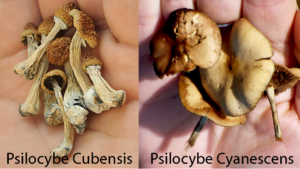THANK YOU!
We sincerely appreciate your generous donation to Entheology Project Inc. As a 508(c)(1)(a) non-profit religious organization, your donation is tax deductible. You will receive an email confirmation for your records, which can be used for tax purposes. Your support helps us continue our mission and make a meaningful impact!
Billing Information
Your credit card will be billed under "Entheology Project Inc." with the description "Donation." If you have any questions or need further assistance, please do not hesitate to contact us. Thank you once again for your support!
Best Regards,
EP Support
info@entheo.info
Looks like there was a problem processing donation.
Magic Mushrooms Safety: A Guide to Responsible Use and Populations at Risk
By EP Admin

Summary
This article aims to raise awareness about the safe and responsible use of magic mushrooms, known scientifically as Psilocybe species. While research has shown potential therapeutic benefits for conditions like depression, anxiety, and PTSD, it’s crucial to be aware of the risks involved. Key points include the danger of misidentifying mushroom species, the importance of the psychological and environmental context (“set and setting”), and the need for caution among those with pre-existing mental health conditions. Additionally, the article discusses the legal ramifications of mushroom use and the risks of combining them with other substances.
“Magic mushrooms,” scientifically known as Psilocybe species, have been a part of traditional healing and spiritual practices for centuries. Recent research has pointed to their potential for treating a range of medical conditions, including depression, anxiety, PTSD, addiction, cluster headaches, and anorexia nervosa 1. However, while these mushrooms are not toxic in the traditional sense, misuse can lead to several types of harm. This blog aims to create awareness about the safety precautions one should take while considering the use of magic mushrooms.
The Risks of Misidentification

One of the primary risks associated with magic mushrooms is the danger of consuming the wrong species. Certain mushrooms are highly toxic and can lead to severe illness or even death if ingested 2. Always consult experts and ensure proper identification before consuming any wild mushrooms.
The Importance of “Set and Setting”
The “set and setting” — that is, your mindset and environment — play a vital role in shaping your experience with magic mushrooms. Being in a supportive, safe, and familiar environment can greatly enhance the experience. On the other hand, using mushrooms in a chaotic or stressful setting can lead to paranoia, anxiety, and risky behavior3.
Pre-existing Mental Health Conditions
Individuals with pre-existing mental health conditions, such as schizophrenia or bipolar disorder, should exercise extreme caution. Consuming psilocybin mushrooms can exacerbate symptoms and worsen the condition 4.
Psychological Preparedness
Magic mushrooms induce significant alterations in perception, mood, and thought. If you are not mentally prepared for these intense experiences, you could find them distressing or even traumatic 5.
Risk of Accidents
The altered state of consciousness created by psilocybin mushrooms significantly increases the risk of accidents and injuries. This risk is heightened if you attempt to drive or operate machinery while under the influence 6.
Legal Ramifications
It’s essential to note that in many places, psilocybin mushrooms are classified as a controlled substance. Possession, cultivation, or distribution could lead to severe legal consequences 7.
Combining with Other Substances
Mixing psilocybin mushrooms with other substances like alcohol or prescription medications can lead to unpredictable and potentially harmful effects 8.
Conclusion
Magic mushrooms have potential therapeutic benefits but should be used responsibly and cautiously. Always do your research, consult healthcare providers when appropriate, and be aware of your mental and physical state before embarking on this journey. Special caution should be exercised by individuals with pre-existing mental health conditions, those in stressful environments, or those considering combining mushrooms with other substances.
Footnotes
- Carhart-Harris, R. L., & Goodwin, G. M. (2017). The therapeutic potential of psychedelic drugs: past, present, and future. Neuropsychopharmacology, 42(11), 2105-2113.
- Benjamin, D. R. (1995). Mushrooms: poisons and panaceas—a handbook for naturalists, mycologists, and physicians. WH Freeman and Company.
- Hartogsohn, I. (2016). Set and setting, psychedelics and the placebo response: An extra-pharmacological perspective on psychopharmacology. Journal of Psychopharmacology, 30(12), 1259-1267.
- Carbonaro, T. M., & Gatch, M. B. (2016). Neuropharmacology of N, N-dimethyltryptamine. Brain research bulletin, 126, 74-88.
- Carhart-Harris, R. L., & Nutt, D. J. (2010). User perceptions of the benefits and harms of hallucinogenic drug use: a web-based questionnaire study. Journal of Substance Use, 15(4), 283-300.
- Hallock, R. M., Dean, A., Knecht, Z. A., Spencer, J., & Taverna, E. C. (2013). A survey of hallucinogenic mushroom use, factors related to usage, and perceptions of use among college students. Drug and alcohol dependence, 130(1-3), 245-248.
- Nutt, D., King, L. A., & Nichols, D. E. (2013). Effects of Schedule I drug laws on neuroscience research and treatment innovation. Nature Reviews Neuroscience, 14(8), 577-585.
- Johnson, M. W., Richards, W. A., & Griffiths, R. R. (2008). Human hallucinogen research: guidelines for safety. Journal of psychopharmacology, 22(6), 603-620.



 Your payment is protected
Your payment is protected